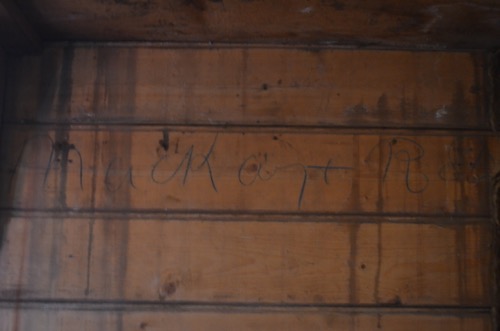Research Update
Today the team made preparations for their upcoming camping trip to the Barwick Valley,which is in the Dry Valleys. In the afternoon we flew to Cape Royds to collect sediment samples. Cape Royds is used as a control site since most of the land is not disturbed by humans. However, the team also collects sediment samples at the helicopter landing sites there. Cape Royds also has a penguin rookery and a historic hut which we visited!
 Our research team hikes up to a sampling site to collect sediments at Cape Royds.
Our research team hikes up to a sampling site to collect sediments at Cape Royds.
Shackleton's Hut
Ernest Shackleton is one of the great Antarctic explorers from the early 20th Century. He first came to Antarctica on Robert Falcon Scott's initial expedition in 1901, but returned again on his own in 1907. Shackleton built a hut at Cape Royds, which sits on the coast between McMurdo Station and Cape Bird. The hut was brought over from London, where it was pre-made in 1907 and purchased for 155 pounds. It was constructed over 10 days and by three weeks it was insulated.
 Shackleton's hut at Cape Royds sits amidst volcanic rocks.
Shackleton's hut at Cape Royds sits amidst volcanic rocks.
Although this is our second historic hut in two days, the magic of stepping back in time is as great as it was yesterday at Cape Evans. I can imagine Shackleton and his men spending 14 months inside the small room.
 A view of the inside of Shackleton's hut.
A view of the inside of Shackleton's hut.
Shackleton and 14 men spent over a year at the hut while conducting science expeditions. Shackleton had his own bedroom, but the other men shared 2-bed cubicles. The men built their beds out of cases and boards from shipping containers. They put wood shavings under blankets for mattresses. The men enjoyed decorating their cubicles. For example, two men created a book shelf out of cloth and placed Charles Dickens books on top of it. They called their cubicle "Number 1 Park Lane", a reference to a London Street. Professor David and Douglas Mawson, famous men on Shackleton's expedition, had scientific equipment in their cubicle and called their bunks "The Pawn Shop." Scrawled by beds were names of people on Shackleton's expedition--I wonder if they wrote those names on the walls themselves.
 Alistair Forbes Mackay's name is scrawled by a bed (presumably his) from Shackleton's 1907 - 1909 expedition. He was an assistant surgeon on the expedition.
Alistair Forbes Mackay's name is scrawled by a bed (presumably his) from Shackleton's 1907 - 1909 expedition. He was an assistant surgeon on the expedition.
 A bed with clothing on it is lit from a window in Shackleton's hut.
A bed with clothing on it is lit from a window in Shackleton's hut.
Although there were tight quarters, the team had some creature comforts. For example a cast iron cooking stove sits at the end of the hut. Shackleton and his men ate freshly baked bread and three warm meals every day from that stove.
 A cast iron stove sits at one end of the hut, once the source of many warm meals.
A cast iron stove sits at one end of the hut, once the source of many warm meals.
Want to check out the hut for yourself? Find out more information and take a Google Tour of the hut here.
Penguins!
With our sampling complete and tour of the hut finished, we all had time to watch Adelie Penguins as they nested in their rookeries. This rookery is visited by Jean Pennycook--a former science teacher who now does research on the Adelies and communicates the science to educators and the public through her website: penguinscience.com.
 Adelie penguins take turns lying on eggs near the shore at Cape Royds.
Adelie penguins take turns lying on eggs near the shore at Cape Royds.
Ice POD
Today's Ice POD is about lenticular clouds -- we saw some starting to form over Mt. Erebus as we waited for our helicopter to take us home! You can download a PowerPoint Slide of today's Ice POD by clicking here:18_icepod.pptx
 Lenticular clouds start to form over Mt. Erebus in today's picture of the day.
Lenticular clouds start to form over Mt. Erebus in today's picture of the day.
Brought to you by...
Today's journal is brought to you by a student from Ms. Martinez's class in Eagle Pass ISD.
 Today's journal is brought to you by a student from Ms. Martinez's class in Eagle Pass iSD.
Today's journal is brought to you by a student from Ms. Martinez's class in Eagle Pass iSD.
Comments